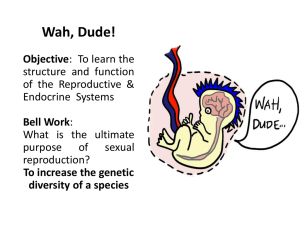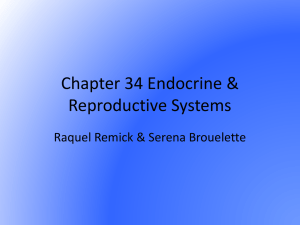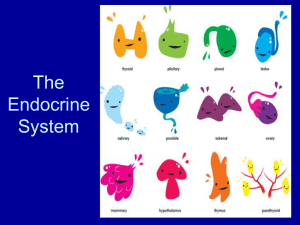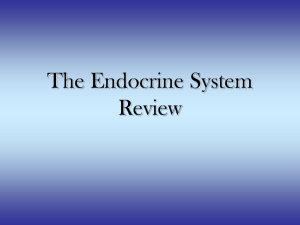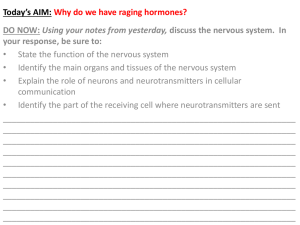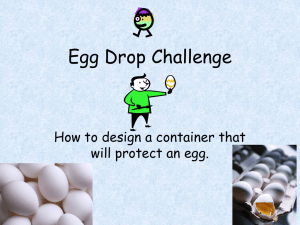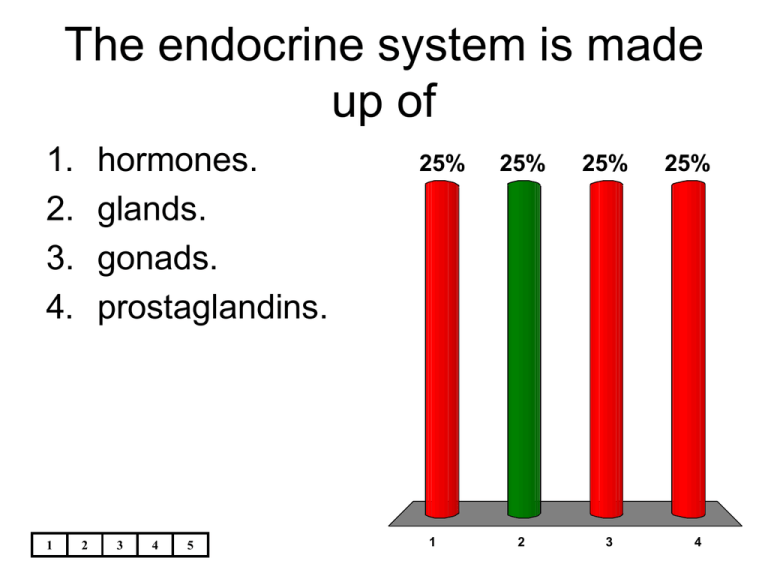
The endocrine system is made
up of
1.
2.
3.
4.
1
hormones.
glands.
gonads.
prostaglandins.
2
3
4
5
25%
1
25%
25%
2
3
25%
4
The nervous system is to a telephone
as the endocrine system is to a
1. chemical
message.
2. television set.
3. radio broadcast.
4. hormone.
1
2
3
4
5
25%
1
25%
25%
2
3
25%
4
The endocrine system
1.
affects only the
reproductive system.
releases hormones into
the bloodstream.
competes with the
nervous system.
is made up primarily of
glands with ducts.
2.
3.
4.
1
2
3
4
5
25%
1
25%
25%
2
3
25%
4
Which of the following is a gland
of the endocrine system?
1.
2.
3.
4.
1
sweat gland
tear gland
pituitary gland
all of the above
2
3
4
5
25%
1
25%
25%
2
3
25%
4
Figure 39–1 shows the body’s
25% 25% 25% 25%
1.
2.
3.
4.
1
hormones.
target cells.
endocrine glands.
exocrine glands.
2
3
4
5
1
2
3
4
Which structure in Figure 39–1 regulates the
level of calcium in the blood?
1.
2.
3.
4.
1
C
D
E
F
2
3
25%
4
5
1
25%
25%
2
3
25%
4
What is the function of the structure
labeled H in Figure 39–1?
1. to produce sex
hormones
2. to produce thyroxine
3. to produce insulin
and glucagon
4. to produce thymosin
1
2
3
4
5
25%
1
25%
25%
2
3
25%
4
Which structure in Figure 39–1 releases
hormones that regulate many of the other
endocrine glands?
25% 25%
25%
25%
1. B
2. D
3. H
4. J
1
2
3
4
5
1
2
3
4
Unlike endocrine glands,
exocrine glands
1. release secretions
through ducts.
2. release hormones.
3. release secretions
directly into the
bloodstream.
4. are found throughout
the body.
1
2
3
4
5
25%
1
25%
25%
2
3
25%
4
Unlike nonsteroid hormones,
steroid hormones
1. remain outside the
target cell.
2. bind to receptors
inside the target cell.
3. have no target cells.
4. are made of
proteins.
1
2
3
4
5
25%
1
25%
25%
2
3
25%
4
A thermostat is a good example
of a(an)
1. hormone-receptor
complex.
2. feedback system.
3. prostaglandin.
4. exocrine gland.
1
2
3
4
5
25%
1
25%
25%
2
3
25%
4
One way the endocrine system helps
maintain homeostasis is by having
1.
each gland secrete only one
hormone.
two hormones with opposite effects
regulate certain things.
only steroid hormones regulate
important functions.
the pituitary gland regulate all the
other glands.
2.
3.
4.
1
2
3
4
5
25%
1
25%
25%
2
3
25%
4
Feedback inhibition means that
an increase in a substance will
1. decrease production of that
substance.
2. increase production of that
substance.
3. increase the production of
other substances.
4. stop production of another
substance.
1
2
3
4
5
25%
1
25%
2
25%
3
25%
4
Which endocrine gland secretes
sex hormones?
1.
2.
3.
4.
1
adrenal medulla
testis
hypothalamus
pituitary
2
3
4
5
25%
1
25%
25%
2
3
25%
4
Which gland fails to produce enough of its
hormone in the disease diabetes mellitus?
1.
2.
3.
4.
1
adrenal
hypothalamus
pancreas
parathyroid
2
3
4
5
25%
1
25%
25%
2
3
25%
4
Which gland produces epinephrine
and norepinephrine?
1.
2.
3.
4.
1
parathyroid
hypothalamus
pituitary
adrenal
2
3
4
5
25%
1
25%
25%
2
3
25%
4
Puberty usually begins between
the ages of
1.
2.
3.
4.
1
5 and 8.
9 and 15.
16 and 19.
20 and 25.
2
3
4
5
25%
1
25%
25%
2
3
25%
4
Which hormones stimulate the
gonads to mature?
1.
2.
3.
4.
1
FSH and LH
estrogens
androgens
testosterone and
progesterone
2
3
4
5
25%
1
25%
25%
2
3
25%
4
The testes and the ovaries do not begin
making active reproductive cells until
1.
2.
3.
4.
1
birth.
fertilization.
gastrulation.
puberty.
2
3
4
5
25%
1
25%
25%
2
3
25%
4
Testosterone is needed for the
development of
1.
2.
3.
4.
1
eggs.
sperm.
the uterus.
all of the above
2
3
4
5
25%
1
25%
25%
2
3
25%
4
Specialized sex cells are known
as
1.
2.
3.
4.
1
gametes.
hormones.
gonads.
organs.
2
3
4
5
25%
1
25%
25%
2
3
25%
4
How many ova do the ovaries
usually produce?
1. one per day
2. about 20 per year
3. one between
them each month
4. 200 million at a
time
1
2
3
4
5
25%
1
25%
25%
2
3
25%
4
Which structure produces
sperm?
1. scrotum
2. epididymis
3. seminiferous
tubules
4. vas deferens
1
2
3
4
5
25%
1
25%
25%
2
3
25%
4
Which of the following is NOT a function of
the female reproductive system?
1. to produce eggs
2. to prepare the body
to carry an embryo
3. to deliver sperm
4. to release eggs into
the Fallopian tubes
1
2
3
4
5
25%
1
25%
25%
2
3
25%
4
Which organ system is responsible
for making and delivering sperm?
1. female
reproductive
system
2. endocrine system
3. nervous system
4. male reproductive
system
1
2
3
4
5
25%
1
25%
25%
2
3
25%
4
Which of the following is NOT a
phase in the menstrual cycle?
1.
2.
3.
4.
1
menstruation
luteal
fertilization
ovulation
2
3
4
5
25%
1
25%
25%
2
3
25%
4
When during the menstrual cycle does an
egg have the best chance of being
fertilized?
1. during the follicular
phase
2. just before
menstruation
3. the beginning of the
luteal phase
4. the day of ovulation
1
2
3
4
5
25%
1
25%
25%
2
3
25%
4
One menstrual cycle usually
lasts about a
1.
2.
3.
4.
1
day.
week.
month.
year.
2
3
4
5
25%
1
25%
25%
2
3
25%
4
During the menstrual cycle, LH
and FSH peak, causing the
1.
corpus luteum to
disintegrate.
follicle to release a
mature egg.
uterine lining to detach
from the uterus.
the lining of the uterus
to thicken.
2.
3.
4.
1
2
3
4
5
25%
1
25%
25%
2
3
25%
4
Menstruation does not occur if
the
1. uterine lining
thickens.
2. estrogen level
falls.
3. progesterone
level falls.
4. egg is fertilized.
1
2
3
4
5
25%
1
25%
25%
2
3
25%
4
A zygote is a
1. two-celled
embryo.
2. solid ball of about
50 cells.
3. blastocyst.
4. fertilized egg.
1
2
3
4
5
25%
1
25%
25%
2
3
25%
4
The chances of fertilization are very
good if sperm are present and a(an)
1. blastocyst is
already present.
2. egg is in the
Fallopian tubes.
3. woman is
menstruating.
4. all of the above
1
2
3
4
5
25%
1
25%
25%
2
3
25%
4
Which of the following are required for
fertilization to occur inside the female body?
1.
Sperm must swim into a Fallopian
tube.
An egg must be present in the
Fallopian tube.
The nucleus of a sperm must enter
an egg cell.
all of the above
2.
3.
4.
1
2
3
4
5
25%
1
25%
2
25%
3
25%
4
During the process of fertilization,
which step happens first?
The sperm’s nucleus enters the egg
cell.
Enzymes break down the protective
layer of the egg cell membrane.
A sperm attaches to a binding site on
the egg cell membrane.
The cell membrane of the egg cell
changes.
1.
2.
3.
4.
1
2
3
4
5
25%
1
25%
2
25%
3
25%
4
Where does fertilization usually
occur?
1.
2.
3.
4.
1
Fallopian tube
ovary
uterus
vagina
2
3
4
5
25%
1
25%
25%
2
3
25%
4
What is the result of
gastrulation?
1.
2.
3.
4.
1
a blastocyst
a zygote
the amnion
germ layers
2
3
4
5
25%
1
25%
25%
2
3
25%
4
Which of the following forms
during gastrulation?
1.
2.
3.
4.
1
endoderm
ectoderm
mesoderm
all of the above
2
3
4
5
25%
1
25%
25%
2
3
25%
4
Which of the following
processes happens last?
1.
2.
3.
4.
1
gastrulation
implantation
fertilization
ovulation
2
3
4
5
25%
1
25%
25%
2
3
25%
4
Which of the following is a
function of the placenta?
1.
mixing the blood of the
mother and the fetus
protecting the fetus from
any drugs or alcohol in
the mother’s body
providing nutrients to
the fetus
cushioning and
protecting the fetus
2.
3.
4.
1
2
3
4
5
25%
1
25%
25%
2
3
25%
4
The placenta connects the
1. fetus to the mother’s
uterus.
2. ectoderm to the
endoderm.
3. umbilical cord to the
mother’s vagina.
4. uterus to the cervix.
1
2
3
4
5
25%
1
25%
25%
2
3
25%
4
If a woman is exposed to HIV
during her pregnancy, the
1.
placenta will protect the fetus from
the HIV viruses.
HIV viruses can cross the placenta
and harm the fetus.
HIV viruses could harm the
placenta.
fetus will probably recover quickly
from the disease.
2.
3.
4.
1
2
3
4
5
25%
1
25%
2
25%
3
25%
4
Which of the following is
characteristic of infancy?
1. Teeth appear.
2. Puberty begins.
3. The first signs of
aging appear.
4. An individual
reaches 70 percent
of her or his adult
height.
1
2
3
4
5
25%
1
25%
25%
2
3
25%
4
Which stage of the human life
cycle occurs first?
1.
2.
3.
4.
1
puberty
adulthood
adolescence
childhood
2
3
4
5
25%
1
25%
25%
2
3
25%
4
Which of the following usually
develop(s) during childhood?
1. personality
2. social skills
3. long bones, to 80
percent of adult
height
4. all of the above
1
2
3
4
5
25%
1
25%
25%
2
3
25%
4
All of the following usually occur
during adolescence EXCEPT
1. a growth spurt.
2. secondary sex
characteristics.
3. puberty.
4. the appearance of
first permanent
teeth.
1
2
3
4
5
25%
1
25%
25%
2
3
25%
4
The endocrine system carries out its job by
releasing target cells into the bloodstream.
_________________________
1. True
50%
50%
2. False
1
2
3
4
5
1
2
Exocrine glands release their secretions into
the bloodstream.
_________________________
1. True
50%
50%
2. False
1
2
3
4
5
1
2
A nonsteroid hormone enters a target cell by
passing across its cell membrane.
_________________________
1. True
50%
50%
2. False
1
2
3
4
5
1
2
Thyroxine inhibits the secretion of TSH by the
anterior pituitary gland, which maintains
homeostasis. _________________________
1. True
2. False
1
2
3
4
50%
5
1
50%
2
The parathyroid glands secrete hormones
that help the body deal with stress.
______________________________
1. True
50%
50%
2. False
1
2
3
4
5
1
2
The highest level of physical strength and
development occurs during adolescence.
_________________________
1. True
50%
50%
2. False
1
2
3
4
5
1
2
If a person’s thyroid gland is removed surgically and
hormone supplements are not taken, the person will
probably lack energy, feel cold, and gain weight.
_________________________
1. True
2. False
1
2
3
4
50%
5
1
50%
2
During puberty the reproductive system
becomes fully functional.
_________________________
1. True
50%
50%
2. False
1
2
3
4
5
1
2
The male reproductive system and the female reproductive
system develop from the same tissues in the embryo.
_________________________
1. True
2. False
1
2
3
4
50%
5
1
50%
2
A female is born with immature eggs and
does not produce any new eggs during her
lifetime. _________________________
1. True
50%
50%
2. False
1
2
3
4
5
1
2
In a 28-day menstrual cycle, menstruation usually
begins on the 14th day of the menstrual cycle.
_________________________
1. True
2. False
1
2
3
4
50%
5
1
50%
2
The process of a sperm joining an egg is
called gastrulation.
_________________________
1. True
50%
50%
2. False
1
2
3
4
5
1
2
If the primary germ layers fail to form normally during
gastrulation, the embryo could develop misshapen organs.
_________________________
1. True
2. False
1
2
3
4
50%
5
1
50%
2
If the placenta were to detach from the mother’s
uterus early, the embryo would stop receiving food
and oxygen. _________________________
1. True
2. False
1
2
3
4
50%
5
1
50%
2
Infancy ends at about two years of age.
_________________________
1. True
2. False
1
2
3
4
50%
5
1
50%
2
Participant Scores
0
0
Participant 1
Participant 2
0
0
0
Participant 3
Participant 4
Participant 5
The ____________________ system is
made up of glands that release their
products into the ____________________.
1
2
3
4
5
0 of 5
____________________ are chemicals that
travel through the bloodstream and affect
the activities of other cells.
1
2
3
4
5
0 of 5
Feedback ____________________ occurs
when an increase in any substance inhibits
the process that produced the substance.
1
2
3
4
5
0 of 5
Figure 39–1
If the structure labeled ____________________ in Figure
39–1 produces too much of its hormone, the result is
nervousness, elevated body temperature, and weight loss.
1
2
3
4
5
0 of 5
If a child’s diet lacks iodine, the ____________________
gland cannot produce its hormone and the child is likely to
develop a condition called ____________________.
1
2
3
4
5
0 of 5
____________________ is a period of rapid
growth and sexual maturation during which the
reproductive system becomes fully functional.
1
2
3
4
5
0 of 5
In the female body, each egg is surrounded
by a ____________________, which breaks
open when the egg is mature.
1
2
3
4
5
0 of 5
If the temperature of the scrotum increases
by 5º Celsius, ____________________ may
not develop properly.
1
2
3
4
5
0 of 5
The shortest phase of the menstrual
cycle is ____________________.
1
2
3
4
5
0 of 5
The testes are contained in an external sac
called the _________________________.
1
2
3
4
5
0 of 5
If a woman is not ovulating, there is no
chance of ____________________.
1
2
3
4
5
0 of 5
During ____________________, three germ layers form.
They are called ____________________, ectoderm, and
mesoderm.
1
2
3
4
5
0 of 5
Almost everything that the mother takes into
her body passes through the
____________________ to the embryo.
1
2
3
4
5
0 of 5
A problem with the ____________________
can disrupt an embryo’s respiration,
nourishment, and excretion.
1
2
3
4
5
0 of 5
The life cycle after birth is as follows:
infancy, ____________________,
adolescence, and ____________________.
1
2
3
4
5
0 of 5
What is the function of the
endocrine system?
1
2
3
4
5
0 of 5
How do the nervous and endocrine systems
differ in the way they help to maintain
homeostasis?
1
2
3
4
5
0 of 5
Compare endocrine glands and exocrine
glands. Give an example of each kind of
gland.
1
2
3
4
5
0 of 5
What are prostaglandins? How are
they different from true hormones?
1
2
3
4
5
0 of 5
Give an example of how the endocrine
system maintains homeostasis.
1
2
3
4
5
0 of 5
Explain why the body of an athlete who takes an
artificial form of testosterone, such as a steroid,
might stop producing its own testosterone.
1
2
3
4
5
0 of 5
Figure 39–1
Which glands are labeled C in Figure 39–1?
What is the main function of these glands?
1
2
3
4
5
0 of 5
What determines whether a human embryo
will develop into a male or a female?
1
2
3
4
5
0 of 5
List the structures that sperm will pass
through from the time they are produced
until they are expelled from the male body.
1
2
3
4
5
0 of 5
What are the four phases of the
menstrual cycle called?
1
2
3
4
5
0 of 5
Which structures will sperm pass through in
the male and female bodies on their way to
fertilizing an egg?
1
2
3
4
5
0 of 5
Many sperm will take the same path toward
fertilizing an egg. What prevents more than
one sperm from fertilizing an egg?
1
2
3
4
5
0 of 5
List the three germ layers that
result from gastrulation.
1
2
3
4
5
0 of 5
Sometimes during pregnancy, the placenta
forms over the cervix. Why might this be a
serious condition for the mother and fetus?
1
2
3
4
5
0 of 5
Name and describe one of the
four stages that follow birth.
1
2
3
4
5
0 of 5
Compare and contrast the ways that steroid
and nonsteroid hormones act on target cells.
1
2
3
4
5
0 of 5
Explain how feedback controls
regulate the body’s metabolism.
1
2
3
4
5
0 of 5
Identify functions of the hormones released
by the pituitary gland. What controls the
release of these hormones?
1
2
3
4
5
0 of 5
Describe the action of
nonsteroid hormones.
1
2
3
4
5
0 of 5
Trace the path of an egg from its follicle.
How does the path of a fertilized egg differ
from that of an unfertilized egg?
1
2
3
4
5
0 of 5
Once sperm enter the female reproductive system, they
usually live for only 12 to 48 hours. Why can’t sperm live as
long inside the female body as they can inside the male
body? What effect does this have on fertilization?
1
2
3
4
5
0 of 5
Starting with the follicular phase, identify the hormones that
are produced during the female’s menstrual cycle. Give the
function of each hormone.
1
2
3
4
5
0 of 5
Spina bifida is a common birth defect in which the
vertebrae of an embryo fail to close during the first month
of development. How might gastrulation be related to spina
bifida? Describe gastrulation in your answer
1
2
3
4
5
0 of 5
What is puberty?
1
2
3
4
5
0 of 5
Why is the reproductive system the least
important body system to the individual but
the most important to the species?
1
2
3
4
5
0 of 5

